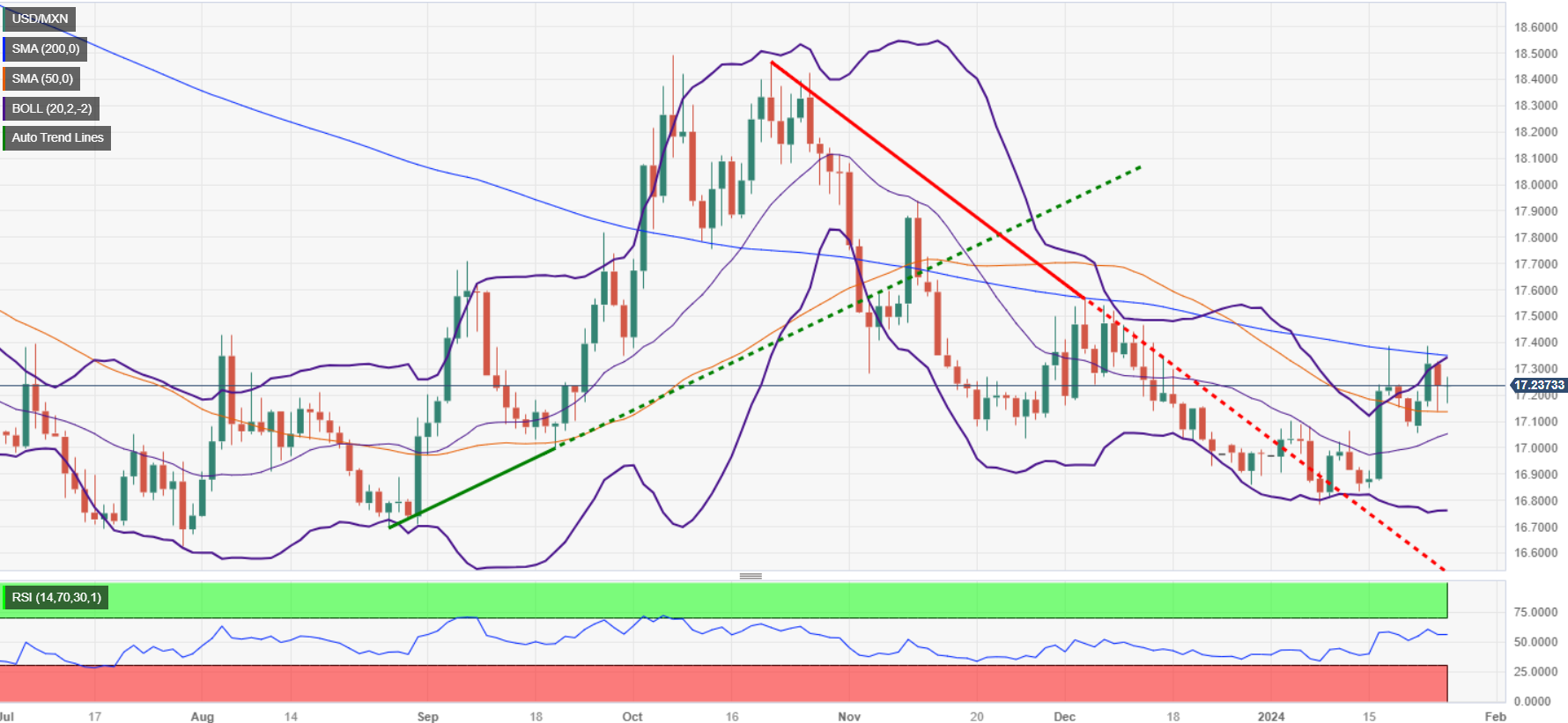Most recent article: Mexican Peso advances amid positive trade data, soft US inflation figures
- Mexican Peso drops 0.08% amidst US economic data showing continued growth and mixed signals from Mexico.
- Strong US GDP growth for Q4 2023 and stable Durable Goods Orders could impact Fed's rate decisions, contrasting with a cooling labor market.
- In Mexico, a lower unemployment rate and rising inflation pose challenges for Banxico's policy direction.
The Mexican Peso (MXN) recovered some ground though is virtually unchanged, printing minuscule gains against the US Dollar (USD) on Thursday after economic data from the United States (US) witnessed the economy continuing to grow above trend, though below last year’s Q3 4.9% final reading. In the meantime, Mexico’s unemployment rate continued to trend lower at a non-seasonally adjusted rate, along with an uptick in inflation in the first half of January, boosting the emerging market currency. At the time of writing, the USD/MXN trades at 17.22, down 0.02% on the day.
The economy in the US remains solid, growing above trend, and might prevent interest rate cuts by the Federal Reserve (Fed) amid a possible reacceleration of inflation. The Gross Domestic Product (GDP) for the last quarter of 2023 exceeded forecasts, while Durable Goods Orders were unchanged and the labor market showed signs of cooling down.
In Mexico, the Unemployment Rate was non-seasonally adjusted for December and dipped compared to November, revealed the National Statistics Agency (INEGI). Meanwhile, according to analysts at BNP Paribas, the latest inflation report in Mexico could deter the Bank of Mexico (Banxico) from easing policy.
Daily Digest Market Movers: Mexican Peso at cross-roads following solid US data
- US GDP for Q4 2023 rose by 3.3% QoQ, smashing estimates of 2%, but less than Q3’s 4.9% increase, according to the US Bureau of Economic Analysis . In 2023, Real GDP rose by 2.5%, sponsored by “increases in consumer spending, nonresidential fixed investment, state and local government spending, exports, and federal government spending,” revealed the report.
- The US Department of Commerce revealed Durable Goods Orders were unchanged in December, with figures clocking 0%, lower than November’s 5.5% rise due to a slump in transportation equipment manufacturing.
- The US Bureau of Labor Statistics reported that for the week concluding on January 20, Initial Jobless Claims rose to 214K, surpassing both the prior week's figures and the projected 200K.
- The Unemployment Rate in Mexico slowed from 2.7% to 2.6% in December as expected by analysts.
- In Mexico, mid-month inflation increased by 0.49%, which was higher than the anticipated 0.38% but lower than December’s 0.59%. Meanwhile, core prices matched expectations at 0.25%, showing a decrease from December's 0.46%.
- Annually, general inflation in Mexico rose 4.9%, above forecasts, and the prior month’s 4.46%, while core inflation cooled from 5.19% to 4.78%, as foreseen.
- Economic Activity in November shrank -0.5% on a monthly basis, lower than forecasts and October’s -0.1% contraction. Annual figures dropped from 4.2% to 2.3%, below forecasts of 3.2% growth.
- The economy in Mexico is beginning to show the impact of high rates set by Banxico at 11.25%, even though most analysts estimate the economy will grow above 2% in 2024. Nevertheless, retail sales missing estimates, the economy growing below 3% in November, and inflation reaccelerating puts a stagflationary scenario in play.
- Pamela Diaz Loubet, Economist for Mexico at BNP Paribas, commented that the outlook for Banxico’s Governing Council is complicated and full of risks. She added that economic activity remains solid, implying that higher interest rates at 11.25% had not yet affected growth and are uncertain to do so. She estimates Mexico’s economy in 2023 grew 3.5%, though it should drop to 2.5% this year.
- Traders trimmed their bets for a dovish Federal Reserve in 2024. They stand at 139 basis points (bps) of cuts from 175 bps last week.
- Despite indications from the December meeting minutes of Banxico (the Central Bank of Mexico) that it may consider easing its monetary policy, the inflation report for January poses a potential obstacle to any such policy relaxation.
- Standard Chartered analysts estimate the Bank of Mexico (Banxico) will lower rates to 9.25% in 2024.
- On January 5, a Reuters poll suggested the Mexican Peso could weaken 5.4% to 18.00 per US Dollar in the 12 months following December.
Technical Analysis: Mexican Peso stays firm as USD/MXN hovers around 17.24
The USD/MXN is virtually unchanged, though trading within familiar levels. If the exotic pair reclaims the 200-day Simple Moving Average (SMA) at 17.35, that could open the door for the pair to challenge the 100-day SMA at 17.42. Further upside is seen above the psychological 17.50 figure, ahead of rallying to the May 23 high from last year at 17.99.
Conversely, if sellers drag prices below the 50-day SMA at 17.13, that would pave the way for further downside. The following support is seen at 17.05, the January 22 low, followed by the 17.00 psychological figure.
USD/MXN Price Action – Daily Chart
US Dollar FAQs
What is the US Dollar?
The US Dollar (USD) is the official currency of the United States of America, and the ‘de facto’ currency of a significant number of other countries where it is found in circulation alongside local notes. It is the most heavily traded currency in the world, accounting for over 88% of all global foreign exchange turnover, or an average of $6.6 trillion in transactions per day, according to data from 2022.
Following the second world war, the USD took over from the British Pound as the world’s reserve currency. For most of its history, the US Dollar was backed by Gold, until the Bretton Woods Agreement in 1971 when the Gold Standard went away.
How do the decisions of the Federal Reserve impact the US Dollar?
The most important single factor impacting on the value of the US Dollar is monetary policy, which is shaped by the Federal Reserve (Fed). The Fed has two mandates: to achieve price stability (control inflation) and foster full employment. Its primary tool to achieve these two goals is by adjusting interest rates.
When prices are rising too quickly and inflation is above the Fed’s 2% target, the Fed will raise rates, which helps the USD value. When inflation falls below 2% or the Unemployment Rate is too high, the Fed may lower interest rates, which weighs on the Greenback.
What is Quantitative Easing and how does it influence the US Dollar?
In extreme situations, the Federal Reserve can also print more Dollars and enact quantitative easing (QE). QE is the process by which the Fed substantially increases the flow of credit in a stuck financial system.
It is a non-standard policy measure used when credit has dried up because banks will not lend to each other (out of the fear of counterparty default). It is a last resort when simply lowering interest rates is unlikely to achieve the necessary result. It was the Fed’s weapon of choice to combat the credit crunch that occurred during the Great Financial Crisis in 2008. It involves the Fed printing more Dollars and using them to buy US government bonds predominantly from financial institutions. QE usually leads to a weaker US Dollar.
What is Quantitative Tightening and how does it influence the US Dollar?
Quantitative tightening (QT) is the reverse process whereby the Federal Reserve stops buying bonds from financial institutions and does not reinvest the principal from the bonds it holds maturing in new purchases. It is usually positive for the US Dollar.
Information on these pages contains forward-looking statements that involve risks and uncertainties. Markets and instruments profiled on this page are for informational purposes only and should not in any way come across as a recommendation to buy or sell in these assets. You should do your own thorough research before making any investment decisions. FXStreet does not in any way guarantee that this information is free from mistakes, errors, or material misstatements. It also does not guarantee that this information is of a timely nature. Investing in Open Markets involves a great deal of risk, including the loss of all or a portion of your investment, as well as emotional distress. All risks, losses and costs associated with investing, including total loss of principal, are your responsibility. The views and opinions expressed in this article are those of the authors and do not necessarily reflect the official policy or position of FXStreet nor its advertisers. The author will not be held responsible for information that is found at the end of links posted on this page.
If not otherwise explicitly mentioned in the body of the article, at the time of writing, the author has no position in any stock mentioned in this article and no business relationship with any company mentioned. The author has not received compensation for writing this article, other than from FXStreet.
FXStreet and the author do not provide personalized recommendations. The author makes no representations as to the accuracy, completeness, or suitability of this information. FXStreet and the author will not be liable for any errors, omissions or any losses, injuries or damages arising from this information and its display or use. Errors and omissions excepted.
The author and FXStreet are not registered investment advisors and nothing in this article is intended to be investment advice.
Recommended content
Editors’ Picks

EUR/USD remains offered and challenges 1.0800
The intense recovery in the US Dollar keeps the price action in the risk complex depressed, forcing EUR/USD to recede further and put the key support at 1.0800 to the test on Friday.

GBP/USD breaks below 1.2900 on stronger Dollar
Persistent buying pressure on the Greenback has pushed GBP/USD to multi-day lows below the 1.2900 level, as investors continue to digest the recent interest rate decisions from both the Fed and the BoE.

Gold meets support around the $3,000 mark
The combined impact of a stronger US Dollar, continued profit taking, and the effects of Quadruple Witching weighed on Gold, pulling its troy ounce price down to around the pivotal $3,000 level on Friday.

US SEC Crypto Task Force to host the first-ever roundtable on crypto asset regulation
The US Securities and Exchange Commission (SEC) Crypto Task Force will host a series of roundtables to discuss key areas of interest in regulating crypto assets. The “Spring Sprint Toward Crypto Clarity” series’ first-ever roundtable begins on Friday.

Week ahead – Flash PMIs, US and UK inflation eyed as tariff war rumbles on
US PCE inflation up next, but will consumption data matter more? UK budget and CPI in focus after hawkish BoE decision. Euro turns to flash PMIs for bounce as rally runs out of steam. Inflation numbers out of Tokyo and Australia also on the agenda.

The Best brokers to trade EUR/USD
SPONSORED Discover the top brokers for trading EUR/USD in 2025. Our list features brokers with competitive spreads, fast execution, and powerful platforms. Whether you're a beginner or an expert, find the right partner to navigate the dynamic Forex market.
